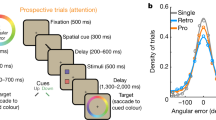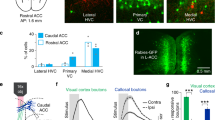Abstract
Prefrontal cortex influences behavior largely through its connections with other association cortices; however, the nature of the information conveyed by prefrontal output signals and what effect these signals have on computations performed by target structures is largely unknown. To address these questions, we simultaneously recorded the activity of neurons in prefrontal and posterior parietal cortices of monkeys performing a rule-based spatial categorization task. Parietal cortex receives direct prefrontal input, and parietal neurons, like their prefrontal counterparts, exhibit signals that reflect rule-based cognitive processing in this task. By analyzing rapid fluctuations in the cognitive information encoded by activity in the two areas, we obtained evidence that signals reflecting rule-dependent categories were selectively transmitted in a top-down direction from prefrontal to parietal neurons, suggesting that prefrontal output is important for the executive control of distributed cognitive processing.
This is a preview of subscription content, access via your institution
Access options
Subscribe to this journal
Receive 12 print issues and online access
$209.00 per year
only $17.42 per issue
Buy this article
- Purchase on Springer Link
- Instant access to full article PDF
Prices may be subject to local taxes which are calculated during checkout







Similar content being viewed by others
References
Medalla, M. & Barbas, H. Diversity of laminar connections linking periarcuate and lateral intraparietal areas depends on cortical structure. Eur. J. Neurosci. 23, 161–179 (2006).
Schwartz, M.L. & Goldman-Rakic, P.S. Callosal and intrahemispheric connectivity of the prefrontal association cortex in rhesus monkey: relation between intraparietal and principal sulcal cortex. J. Comp. Neurol. 226, 403–420 (1984).
Cavada, C. & Goldman-Rakic, P.S. Posterior parietal cortex in rhesus monkey: II. Evidence for segregated corticocortical networks linking sensory and limbic areas with the frontal lobe. J. Comp. Neurol. 287, 422–445 (1989).
Andersen, R.A., Asanuma, C., Essick, G. & Siegel, R.M. Corticocortical connections of anatomically and physiologically defined subdivisions within the inferior parietal lobule. J. Comp. Neurol. 296, 65–113 (1990).
Goldman-Rakic, P.S. Circuitry of primate prefrontal cortex and regulation of behavior by representational memory. in. Handbook of Physiology: The Nervous System: Higher Functions of the Brain (eds. Mountcastle, V.B., Plum, F. & Geiger, S.R.) 373–417 (Am. Physiol. Soc., Bethesda, Maryland, USA, 1987).
Andersen, R.A. & Cui, H. Intention, action planning, and decision making in parietal-frontal circuits. Neuron 63, 568–583 (2009).
Qi, X.L. et al. Comparison of neural activity related to working memory in primate dorsolateral prefrontal and posterior parietal cortex. Front Syst. Neurosci 4, 12 (2010).
Chafee, M.V. & Goldman-Rakic, P.S. Matching patterns of activity in primate prefrontal area 8a and parietal area 7ip neurons during a spatial working memory task. J. Neurophysiol. 79, 2919–2940 (1998).
Funahashi, S., Chafee, M.V. & Goldman-Rakic, P.S. Prefrontal neuronal activity in rhesus monkeys performing a delayed anti-saccade task. Nature 365, 753–756 (1993).
Gnadt, J.W. & Andersen, R.A. Memory related motor planning activity in posterior parietal cortex of macaque. Exp. Brain Res. 70, 216–220 (1988).
Buschman, T.J. & Miller, E.K. Top-down versus bottom-up control of attention in the prefrontal and posterior parietal cortices. Science 315, 1860–1862 (2007).
Nieder, A. & Miller, E.K. A parieto-frontal network for visual numerical information in the monkey. Proc. Natl. Acad. Sci. USA 101, 7457–7462 (2004).
Nieder, A., Freedman, D.J. & Miller, E.K. Representation of the quantity of visual items in the primate prefrontal cortex. Science 297, 1708–1711 (2002).
Vallentin, D. & Nieder, A. Representations of visual proportions in the primate posterior parietal and prefrontal cortices. Eur. J. Neurosci. 32, 1380–1387 (2010).
Tudusciuc, O. & Nieder, A. Contributions of primate prefrontal and posterior parietal cortices to length and numerosity representation. J. Neurophysiol. 101, 2984–2994 (2009).
Swaminathan, S.K. & Freedman, D.J. Preferential encoding of visual categories in parietal cortex compared with prefrontal cortex. Nat. Neurosci. 15, 315–320 (2012).
Merchant, H., Crowe, D.A., Robertson, M.S., Fortes, A.F. & Georgopoulos, A.P. Top-down spatial categorization signal from prefrontal to posterior parietal cortex in the primate. Front Syst. Neurosci 5, 69 (2011).
Goodwin, S.J., Blackman, R.K., Sakellaridi, S. & Chafee, M.V. Executive control over cognition: stronger and earlier rule-based modulation of spatial category signals in prefrontal cortex relative to parietal cortex. J. Neurosci. 32, 3499–3515 (2012).
Box, G.E.P., Jenkins, G.M. & Reinsel, G.C. Time Series Analysis: Forecasting and Control (Prentice-Hall, Upper Saddle River, New Jersey, USA, 1994).
Granger, C.W.J. & Newbold, P. Forecasting Economic Time Series (Academic, New York, 1977).
Christova, P., Lewis, S.M., Jerde, T.A., Lynch, J.K. & Georgopoulos, A.P. True associations between resting fMRI time series based on innovations. J. Neural Eng. 8, 046025 (2011).
Sugrue, L.P., Corrado, G.S. & Newsome, W.T. Matching behavior and the representation of value in the parietal cortex. Science 304, 1782–1787 (2004).
Gottlieb, J. & Balan, P. Attention as a decision in information space. Trends Cogn. Sci. 14, 240–248 (2010).
Peck, C.J., Jangraw, D.C., Suzuki, M., Efem, R. & Gottlieb, J. Reward modulates attention independently of action value in posterior parietal cortex. J. Neurosci. 29, 11182–11191 (2009).
Platt, M.L. & Glimcher, P.W. Neural correlates of decision variables in parietal cortex. Nature 400, 233–238 (1999).
Barraclough, D.J., Conroy, M.L. & Lee, D. Prefrontal cortex and decision making in a mixed-strategy game. Nat. Neurosci. 7, 404–410 (2004).
Desimone, R. & Duncan, J. Neural mechanisms of selective visual attention. Annu. Rev. Neurosci. 18, 193–222 (1995).
Fitzgerald, J.K. et al. Biased associative representations in parietal cortex. Neuron 77, 180–191 (2013).
Nee, D.E. & Brown, J.W. Dissociable frontal-striatal and frontal-parietal networks involved in updating hierarchical contexts in working memory. Cereb. Cortex 23, 2146–2158 (2013).
Gregoriou, G.G., Gotts, S.J., Zhou, H. & Desimone, R. High-frequency, long-range coupling between prefrontal and visual cortex during attention. Science 324, 1207–1210 (2009).
Gregoriou, G.G., Gotts, S.J. & Desimone, R. Cell-type-specific synchronization of neural activity in FEF with V4 during attention. Neuron 73, 581–594 (2012).
Chafee, M.V. & Goldman-Rakic, P.S. Inactivation of parietal and prefrontal cortex reveals interdependence of neural activity during memory-guided saccades. J. Neurophysiol. 83, 1550–1566 (2000).
Ferraina, S., Pare, M. & Wurtz, R.H. Comparison of cortico-cortical and cortico-collicular signals for the generation of saccadic eye movements. J. Neurophysiol. 87, 845–858 (2002).
Sherman, S.M. & Guillery, R.W. Distinct functions for direct and transthalamic corticocortical connections. J. Neurophysiol. 106, 1068–1077 (2011).
Acknowledgements
We thank A. Georgopoulos for fundamental intellectual contributions to, and longstanding support of, this work. We thank P. Goldman-Rakic for critical insights into the network basis of prefrontal cortex function that strongly influenced this study. We thank D. Evans and D. Boeff for excellent technical assistance. We thank J. Ortiz and S. Te Nelson for assistance in training of nonhuman primates. Supported by the US National Institutes of Health (grant R01 MH077779 and R24MH069675), the Department of Veterans Affairs and the American Legion Brain Sciences Chair. R.K. Blackman was supported by US National Institutes of Health grant T32 GM008244. The views and opinions expressed in this work are those of the authors solely and not those of the United States Federal Government.
Author information
Authors and Affiliations
Contributions
D.A.C. and M.V.C. analyzed the data and wrote the manuscript. S.J.G., R.K.B., S.S., S.R.S. and A.W.M. edited the manuscript. S.J.G. and M.V.C. designed the experiment, and S.R.S. and A.W.M. contributed to experimental design. S.J.G. trained the monkeys and collected the neural data. R.K.B., M.V.C. and S.S. assisted in neuronal data collection.
Corresponding author
Ethics declarations
Competing interests
The authors declare no competing financial interests.
Supplementary information
Supplementary Text and Figures
Supplementary Figures 1–10 (PDF 767 kb)
Rights and permissions
About this article
Cite this article
Crowe, D., Goodwin, S., Blackman, R. et al. Prefrontal neurons transmit signals to parietal neurons that reflect executive control of cognition. Nat Neurosci 16, 1484–1491 (2013). https://doi.org/10.1038/nn.3509
Received:
Accepted:
Published:
Issue Date:
DOI: https://doi.org/10.1038/nn.3509
This article is cited by
-
Cortical thickness of the inferior parietal lobule as a potential predictor of relapse in men with alcohol dependence
Brain Imaging and Behavior (2023)
-
Dual-axes of functional organisation across lateral parietal cortex: the angular gyrus forms part of a multi-modal buffering system
Brain Structure and Function (2023)
-
The Association Between Internet Gaming Disorder and Impulsivity: A Systematic Review of Literature
International Journal of Mental Health and Addiction (2022)
-
Reward-related choices determine information timing and flow across macaque lateral prefrontal cortex
Nature Communications (2021)
-
Attentional and cognitive monitoring brain networks in long-term meditators depend on meditation states and expertise
Scientific Reports (2021)



